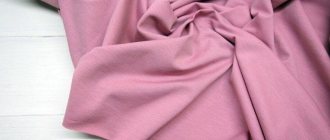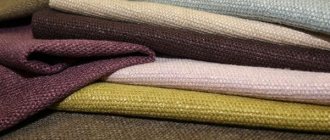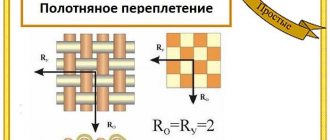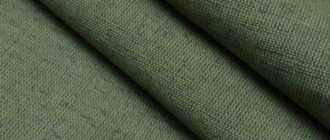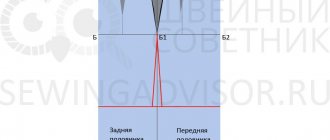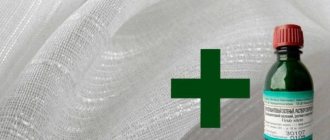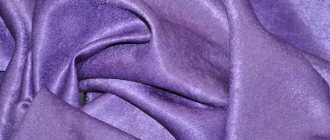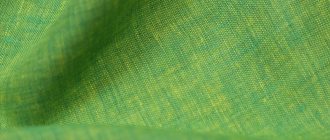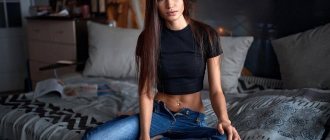What kind of fabric
A person who is far from sewing may have a question about what dress fabric is. It should be understood that this is not the name of a specific material, such as viscose, gabardine, tweed or silk, but of a whole group. The name dress fabric means that the material is suitable for sewing dresses and other underwear.
Suit and dress fabrics can be dense and hold their shape well, such as tweed, gabardine, and crepe. Or they can be light, flowing like silk, chiffon, crepe de chine or niagara.
The quality of the material and its properties will depend on the manufacturer. Italian dress fabrics made of cotton, silk, and linen are highly valued. Premium woolen fabrics are woven in the UK.
By weave type
The properties of the fabric depend not only on the type of raw material used, but also on the method of weaving the threads. The following classification of dress fabrics is based on their division according to this criterion.
Ordinary (smooth)
Linen
This is one of the simplest types of weaving longitudinal and transverse threads (key and weft), when the two sides of the fabric are similar. The higher the density, the stiffer the fabric will be. They are cut without problems and are used for sewing ordinary simple dresses and loose-fitting sundresses, since they practically do not stretch and will restrict movement when choosing a tight-fitting style.
Taffeta made from various fibers is used for dresses. Polyester taffeta is thin, shiny, slightly rustles, and holds its shape. Viscose taffeta is softer. It combines perfectly with lace and guipure and is usually used for sewing elegant and lace dresses.
Among the types of shiny fabrics, another group consists of coated .
Twill weave fabrics are very dense; a characteristic feature is that the threads on the surface create diagonal stripes (ribbles), in most cases at an angle of 45 degrees. A similar material (twill) stretches much better than linen, especially diagonally, it is softer, but less strong. Almost different versions of dresses are sewn from twill. When cutting, you need to take into account the stretchability of the fabric and the possibility of distortions.
Satin (satin)
The outer side comes out smooth and shiny. Satin material is durable and abrasion-resistant, quite soft and flexible, drapes perfectly. This is one of the very expensive fabrics for evening dresses and other suits , wedding and ballroom.
Finely patterned
the matting is similar to linen, although it can be made of cotton, linen, wool, silk, or polyester. The threads in it are connected in pairs, organizing a small convex pattern. It is distinguished by its softness and elasticity, wrinkles little and is undemanding in care. This is a costume and dress fabric; women's and men's suits and hats are made from it.
Crepe is one of the very common types of weave for dress fabrics. Varieties: crepe- cotton dress silks , crepe-georgette, crepe-chiffon, crepe de Chine. During manufacturing, threads of any composition are used, wound to the right and left. The outer surface comes out rough (not counting crepe-satin). This material is quite soft, drapes well and practically does not wrinkle. It is necessary to take into account that the crepe frays when cutting, so it is necessary to leave small allowances.
Large patterned
Compound
Fibers in dress fabrics can be natural, artificial, or synthetic. The composition of the fabric can be mixed. For example, stretch cotton (with lavsan or lycra), linen + lavsan, wool + cotton or wool + silk + viscose.
Natural materials include:
- Dress linen is a durable, highly breathable material. It has high thermoregulation. Linen dress fabrics wrinkle a lot and are not elastic. It is better to sew loose-fitting clothes from them;
- Cotton is often used to create dress fabrics. The material is pleasant to the body and hygroscopic. Depending on the density, both summer and demi-season items are sewn from it;
- silk is a light, flowing material with a beautiful, delicate shine. It is hypoallergenic, wicks away moisture well, retains heat, and is very pleasant to the body. Both evening dresses and business-style clothes are made from it. The material requires careful care: if washed incorrectly, it stretches;
- Woolen dress fabrics can be either thin or dense. They retain heat well and allow the body to breathe. They require careful care: if washed incorrectly, they shrink or lose their shape.
Artificial fabrics are made from natural raw materials that have undergone special processing. Their properties are close to natural. They remove heat well and allow the body to breathe. They are more elastic, the products do not deform or stretch. The starting raw materials are cellulose from pine, beech, and eucalyptus. Below are the most popular artificial materials:
- viscose - a dress fabric with characteristics close to cotton, but the material is more elastic;
- cupro - similar in characteristics to silk. Although the material is made from wood pulp and cotton floss;
- lyocell is the starting material of eucalyptus cellulose. The material allows the body to breathe and absorbs moisture no worse than cotton.
Synthetic fabrics are made from polymer fibers. They are more durable, but their hygienic indicators are much worse than those of natural and artificial materials.
Silk
Light shiny silk fabric has always attracted the attention of people who want to dress beautifully. According to one version, silk became an indirect cause of the Great Migration and the fall of the Roman Empire. Fortunately, nowadays everyone can buy this material or clothes made from it. The largest producers are China, Uzbekistan, Brazil, Thailand, India, Vietnam, Iran.
Silk is woven from the threads that make up the cocoon of the silkworm. The quality of the resulting fibers determines the type of silk fabric - it can be taffeta, satin, chiffon, brocade, crepe . In their pure form, silk threads are used relatively rarely, since the fabric wrinkles a lot and is afraid of the bright sun, so a certain amount of artificial fibers is often added to them. This has a beneficial effect on the quality of the canvas.
Main characteristics of the material:
- It's never hot or cold in a silk dress.
- Absorbs and releases moisture well.
- Allows the body to “breathe” freely.
- The fabric is light and pleasant to the touch.
- The material lays down in beautiful soft folds.
- It washes well (though it also gets dirty quickly).
Silk is mainly used to make floor-length evening dresses, light summer dresses and sundresses, and expensive underwear. The fabric goes well with the lace trim. Silk clothing is recommended to be worn by people suffering from skin diseases, as well as diseases of the musculoskeletal system and cardiovascular system.
How to care for a silk dress?
This material does not like machine washing, so items will have to be washed by hand using a mild detergent (the packaging should be marked “for silk fabrics”). Add a spoonful of vinegar to the last rinse water - the color will become brighter. Silk cannot be twisted. First, the item is lightly wrung out with a terry towel, then straightened and dried on a horizontal surface away from the sun.
When ironing, set the iron to “silk” mode, steaming is allowed. It is not recommended to splash water - it will leave streaks on the dress.
Is it difficult to sew from silk? The fear of ruining expensive, beautiful material often hinders novice dressmakers and for good reason. Silk requires a certain amount of experience, accuracy and care. Be sure to adjust the machine well, use only thin needles and threads, and very sharp scissors. The fabric has a movable structure, so when cutting it is better to place some dense material under it.
Types and their properties
Classification of dress fabrics; their characteristics and properties depend on the type of weave.
Material with a smooth surface is woven:
- plain weave, when the warp and weft threads are intertwined in a checkerboard pattern. Calico, chiffon, linen, and stretch fabrics are produced in a similar way.
- satin - the front side is shiny, and the back side is matte (satin, satin).
- twill (diagonal) - a thin scar is formed on the surface of the fabric, running at an angle of 45° (gabardine, tweed, denim).
Finely patterned fabrics are woven crepe weave. Twisted threads are used, so the front side of crepe dress fabrics is rough (crepe georgette, crepe de Chine, barbie).
Material with a large pattern on the surface is obtained jacquard weave. Usually evening dresses are made from it. The most famous jacquard fabric is brocade.
A separate group is pile materials. These are soft dress fabrics, velvet, velor. They are used to make both evening and casual wear.
The color of dress fabrics is varied (red, white, electric, black, blue). Many materials allow you to apply various prints to their surface. These can be floral, geometric, fantasy ornaments. Timeless classic dress fabric in check or stripes, polka dots.
Velvet fabric. Photo
Dress fabrics for children are classified into a separate group. The quality of the raw material, its environmental friendliness and the safety of the dyes are important to them.
Advantages of silk
This material is not inferior in characteristics and properties to other types of dress fabrics. Among the advantages should be highlighted:
- Easy to wash and dries very quickly.
- Allows you to maintain optimal body temperature: it warms you in winter, and, on the contrary, cools you in summer.
- Has preventive properties. Doctors recommend wearing silk clothes for those who suffer from various types of dermatitis, arthritis, diseases of the cardiovascular system and rheumatism.
- High quality and natural material does not wrinkle.
Despite these advantages, this dress fabric, the composition of which is completely natural, has one main drawback. Silk gets dirty very quickly. It is worth noting that even one drop of water will leave a mark on the dress.
Advantages
Dress fabrics made from natural or artificial materials are comfortable to wear. They provide good heat exchange and are breathable. Artificial fabrics stretch well, while retaining the shape of the product.
Mixed materials with a percentage of synthetic fibers of no more than 20% are more wear-resistant. They wrinkle less and are not deformed when worn.
Softly draping, thin and light dress fabrics made from silk or viscose create flowing silhouettes. Wool fabrics hold their shape well.
Why is jacquard so attractive?
This dress fabric has a number of advantages that are worth mentioning. First of all, the material:
- has high strength;
- wear-resistant;
- has low weight, despite its rigidity and density;
- does not change appearance due to temperature changes;
- does not wrinkle;
- does not cause allergies;
- repels dust.
Application area
Depending on the composition and texture, you can sew an evening dress, a formal office dress, or a simple everyday dress from dress fabric.
The fabric for the dress is selected based on its model. Office clothes are made from gabardine, barbie and other thick suit materials. Poplin is suitable for casual summer wear.
Dress knitwear is used for sewing tight dresses, turtlenecks, T-shirts, and thin sweatshirts. It usually contains a small amount of synthetic fibers and holds its shape well.
Pencil pants and skirts are made from stretch. The material stretches well, but does not deform. With a small percentage of synthetics, it allows the body to breathe.
For winter dresses, tweed, angora, and mixed woolen fabrics are used. They retain heat well and are pleasant to the body.
Dress fabric for children's clothing must be 100% natural. Most often, cotton fabrics, wool + cotton, cotton + viscose are used to sew it.
Care
Features of care for dress fabrics depend on their composition. Before washing, you should carefully study the information on the label. If this is not possible, you should adhere to the general rules:
- Dyed linen items are washed at a water temperature of no higher than 30°C. Unpainted – 40°С-60°С;
- Cotton, depending on the density of the material, is washed at a water temperature of 30°C to 50°C;
- viscose fabrics need careful care: wash at 30°C, spin gently;
- Wool is washed only at 30°C in a special mode. Strong rubbing and twisting when hand washing is prohibited. Dry the products laid out on a horizontal surface;
- Silk is washed by hand or dry-cleaned. Machine washable on delicate cycle. It is prohibited to press the products by machine; I press them lightly by hand. Dry things laid out on a horizontal surface;
- for silk and wool, it is necessary to use special detergents; it is better if they are liquid;
- synthetics are washed at a temperature of 30°C;
- When caring for mixed products, you need to focus on the fiber that is more abundant in the composition.
Linen and cotton are ironed with a well-heated iron. For wool and silk, delicate modes are used. Products made from natural fabrics should be stored hung on hangers. It is better to wear special cotton covers on top.
Synthetics are ironed at low temperatures. Things are hung or neatly folded.
Dear readers of the Tkan.Club website, if you still have questions on this topic, we will be happy to answer them. Leave your reviews, comments, share stories if you have dealt with this material! Your life experience may be useful to other readers.
Viscose
Viscose fabric appeared at the end of the 19th century. The French engineer Ilie de Chardonnay managed to obtain textile fiber from chemically treated wood cellulose. The material turned out to be so successful that it is still very popular. Viscose can be a worthy replacement for cotton, wool, silk and other natural fabrics. Dresses made from viscose are durable and very elegant.
Advantages:
- In hot weather, the fabric gives a feeling of coolness.
- Has a pleasant matte shine.
- Practically does not wrinkle.
- Absorbs moisture perfectly.
- Not electrified.
- Drapes beautifully.
Material care
Elegant, business and casual dresses are made from viscose, as they fit well, do not wrinkle and retain a fresh and neat appearance for a long time. Unfortunately, for all its advantages, viscose is a rather capricious material. The fabric cannot be washed in hot water, twisted or wrung out. Machine washable in hand wash mode. Products made from viscose are dried and ironed in the same way as silk.
How does it behave when sewing?
Viscose is considered a relatively easy fabric to process, so even inexperienced craftswomen can work with it. Some viscose fabrics fray a lot along the cut, so when cutting you should leave a small margin.
